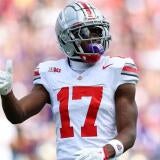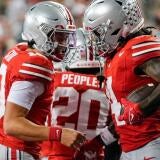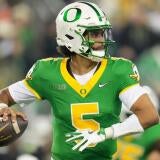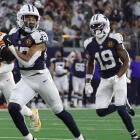NFL combine 2023 drills: How three-cone times for edge rushers have indicated future success over past decade
Factoring in height and weight was the foundation of this study

The 2023 draft class of edge rushers is good. Damn good. From Will Anderson Jr. to Tyree Wilson to Lukas Van Ness to Andre Carter II to Myles Murphy and a myriad of other top talents, it's a collection of outside pass rushers with a varying array of power, pass-rushing moves, burst, bend, and closing speed.
We could see as many as seven edge rushers in Round 1, and probably five or more will go before the end of Day 2. For real.
For more extensive draft content, check out our latest prospect rankings and mock drafts, as well as our new weekly podcast, "With the First Pick", featuring former Vikings general manager Rick Spielman. (Check out the latest episode below.)
The combine has a drill -- the three-cone -- that strongly correlates with NFL success at the edge-rusher position. Probably because it's a drill that explicitly measures a prospect's ability to tightly bend the corner and accelerate around it. Very translatable to what edge rushers are asked to do on many of their rushes to the quarterback on passing plays.
The 7.00-second threshold has forever been the gold-standard in three-cone times for edge defenders. If you're under that time, you're good. If you're not, red flag. And, sure, we all collectively realized there should be more leeway with that time for a heavier prospect.
Well, back at the outset of the pandemic, I spent some time adding more context to that prestigious 7.00 threshold for edge rushers because I realized we needed to go deeper than just adjusting how quick an edge rusher's three-cone time was strictly based on weight. Height had to be considered, too, because 6-foot-2 and 260 pounds is anatomically much different than 6-5, 260.
So I got to work, mapping out the heights, weights, and three-cone times for edge rushers over the past 10 years at the combine in a scatter chart and used Excel to draw a best-fit line based on the figures. That line would clearly show where the three-cone time threshold should really be based on an edge defender's height and weight.
What I found was striking. Before I show you the charts, here are some guidelines for what I call the Calculated Combine Context (CCC) study. And this is an update of last year's debut CCC article, which you can find here.
- The sample size here is 2013 to 2022 for edge rushers. I couldn't rely on pro day numbers in a study focusing on exact numbers out to the hundredth of a second like this one.
- Players' heights were rounded up starting at one-half of an inch. (For example: 6'2 1/2" counted as 6-3.)
- Only edge rushers who participated in the three-cone drill at the combine were included in the study.
And here is the study's key:
- Players highlighted in black ran a slower time than the best-fit line for their height but have made a Pro Bowl.
- Players highlighted in green ran a faster time than the best-fit line for their height and have made a Pro Bowl.
- The X axis is player weight.
- The Y axis is three-cone time in seconds.
Now, I'm certainly aware a Pro Bowl appearance isn't today's finest method of identifying a quality player. And while Pro Bowl voting has gotten watered down over the years, it's still a mostly reliable indicator of who's at least pretty good, and who isn't.
Below are the charts, starting with the 6-2 edge rushers and finishing with the 6-5 edge rushers. The vast majority of them from 2013 to 2022 were in that height range.

Not an enormous sample here, and there's only one Pro Bowl (Yannick Ngakoue) outnumber the Pro Bowler under the line -- zero. Not a tremendous start for those thinking three-cone time matters for edge rushers. A non-Pro Bowl observation: there is both exactly one promising rusher under the line (Baron Browning) and one who was a solid rusher in his day above it (Takk McKinley)
Now onto the 6-3 rushers. There's way more of them.

This is the subsection of the sample size in which a real trend emerges. Six of the Pro Bowlers under the line (Vic Beasley, Harold Landry, Jamie Collins, Micah Parsons, Khalil Mack, Frank Clark) outnumber the two above the line (DeMarcus Lawrence, Matthew Judon).
Thanks in large part to Parsons and Mack, this group features six first-team All-Pro selections, along with a Defensive Rookie of the Year and Defensive Player of the Year nod.
Heading into the 6-4 group, we're at six Pro Bowlers under the line (faster than than the expected three-cone time) and three above the line (slower). Beyond the Pro Bowl, Kyle Van Noy is a quality player above the line, but there are two solid contributors under it (Derek Barnett and Milton Williams.)
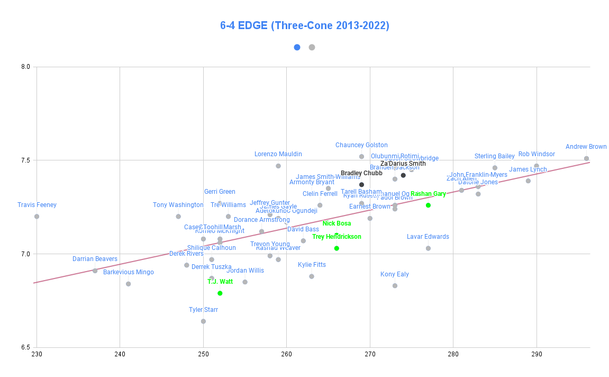
Here, the trend continues. There are four Pro Bowlers below the line (Trey Hendrickson, T.J. Watt, Rashan Gary, and Nick Bosa) to just two above it (Bradley Chubb, Za'Darius Smith).
Through the 6-4 rushers, there are 10 defenders below their best-fit line and five above it.

At this height, there are five Pro Bowlers under the line (Joey Bosa, Brian Burns, Ziggy Ansah, Maxx Crosby, and Anthony Barr) to just two above it (Josh Allen and Jadeveon Clowney.) Outside of the Pro Bowl, Sam Hubbard and Preston Smith are below the line.
That moves the final count to Pro Bowl count 15 who had a three-cone time below their respective best-fit line and seven had a time that was above the line. Last year's count was 23 to 7, and much of the reason the difference isn't as striking is because there aren't as many edge-rusher prospects participating in the three-cone drill like they used to.
Even if we already simply expected the faster times to correlate with the better players, with these charts, we now know what constitutes a "fast" time relative to height and weight for edge rushers. (Oh, and Aidan Hutchinson would've been well below the CCC best-fit line among 6-7 edge rushers.)
Going into the 2023 combine, feel free to use these CCC charts to check how "good" three-cone times are for all the top edge rushers after getting their measurements.


